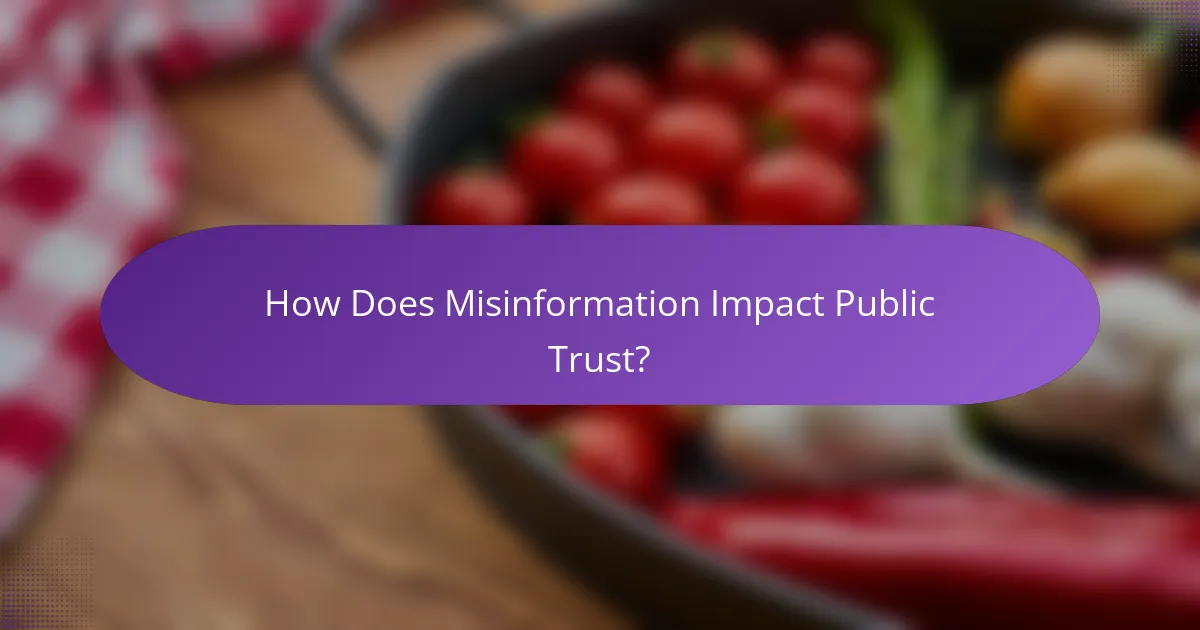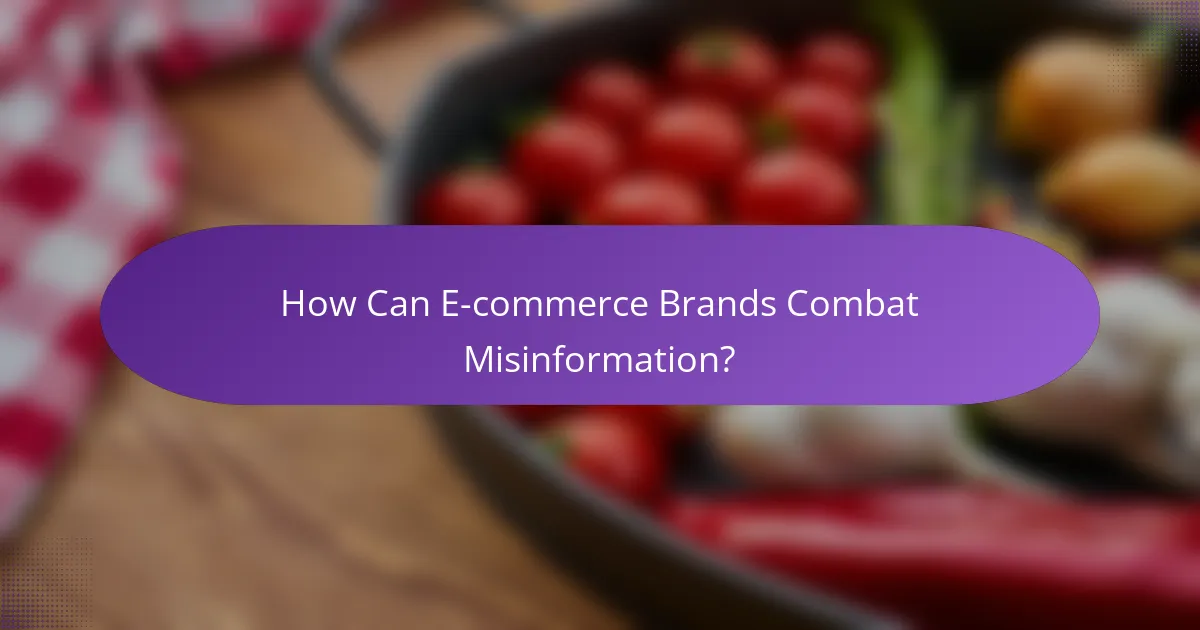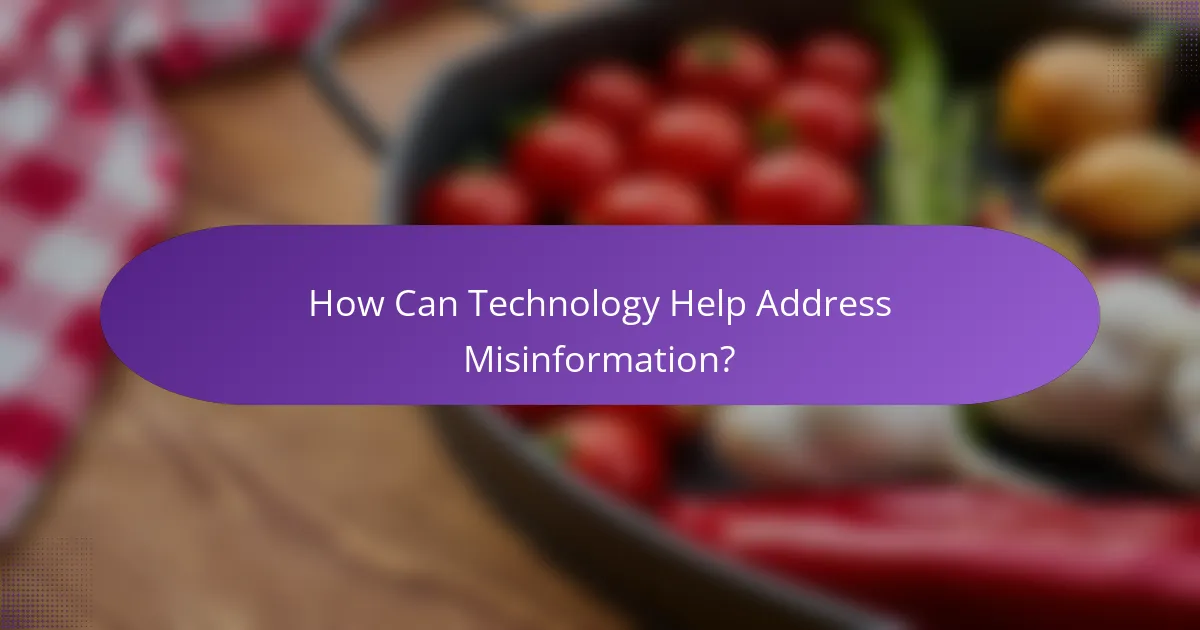The rise of misinformation poses significant challenges to public trust, as it fosters confusion and skepticism towards reliable sources. This erosion of confidence can lead to a fragmented understanding of vital issues, making it essential to implement effective mitigation strategies such as fact-checking and media literacy programs. By enhancing transparency and communication, organizations can combat misinformation and rebuild trust within communities.

How Does Misinformation Impact Public Trust?
Misinformation significantly undermines public trust by creating confusion and skepticism towards credible sources. As individuals encounter conflicting information, their confidence in news outlets and institutions erodes, leading to a fragmented understanding of critical issues.
Decreased trust in news sources
The prevalence of misinformation leads to a marked decrease in trust towards news sources. When audiences are exposed to false or misleading information, they often become wary of all media, including reputable outlets. This skepticism can result in a preference for alternative sources that may not adhere to journalistic standards.
For example, surveys indicate that many people now rely on social media for news, which often lacks verification processes. This shift can perpetuate the cycle of misinformation, as users may prioritize sensational content over factual reporting.
Increased polarization among communities
Misinformation contributes to heightened polarization within communities by reinforcing existing biases. When individuals encounter information that aligns with their beliefs, they are more likely to accept it without scrutiny, leading to echo chambers where dissenting views are dismissed.
This polarization can manifest in various ways, such as increased hostility during discussions about political or social issues. Communities may become divided, making it challenging to reach consensus on important matters, ultimately affecting social cohesion.
Challenges in decision-making
The spread of misinformation complicates decision-making processes for individuals and organizations alike. When faced with conflicting information, people may struggle to make informed choices, whether regarding health, politics, or financial matters.
For instance, during public health crises, misinformation about treatments or preventive measures can lead to poor health decisions. To mitigate this, individuals should verify information through trusted sources and consider multiple perspectives before concluding.

What Mitigation Strategies Are Effective?
Effective mitigation strategies for misinformation include fact-checking initiatives, media literacy programs, and collaboration with social media platforms. These approaches aim to reduce the spread of false information and enhance public understanding of credible sources.
Fact-checking initiatives
Fact-checking initiatives involve organizations or platforms that verify the accuracy of claims made in public discourse. These initiatives often publish findings on their websites or social media, helping to clarify misinformation for the public.
For instance, organizations like Snopes and FactCheck.org provide detailed analyses of trending claims, often categorizing them as true, false, or misleading. Engaging with these resources can empower individuals to discern fact from fiction.
Media literacy programs
Media literacy programs educate individuals on how to critically evaluate information sources. These programs often target schools, community centers, and online platforms to reach diverse audiences.
By teaching skills such as identifying biases, verifying sources, and understanding the context of information, these programs help people navigate the complex media landscape. For example, workshops might include exercises on analyzing news articles or recognizing clickbait headlines.
Collaboration with social media platforms
Collaboration with social media platforms is crucial in combating misinformation, as these platforms are often where false information spreads rapidly. Partnerships can involve implementing algorithms that flag or reduce the visibility of misleading content.
Additionally, platforms like Facebook and Twitter have introduced features that link to fact-checking resources or provide context for posts that may be misleading. Users are encouraged to report suspicious content, which can help improve the overall quality of information shared online.

How Can E-commerce Brands Combat Misinformation?
E-commerce brands can effectively combat misinformation by adopting proactive strategies that enhance transparency and foster trust. By focusing on clear communication, engaging with customers, and utilizing feedback, brands can mitigate the impact of false information.
Transparent communication practices
Transparent communication involves sharing accurate information openly and consistently. E-commerce brands should provide clear product descriptions, pricing, and policies to avoid misunderstandings. Regular updates about changes in inventory or shipping can also help build credibility.
Brands can utilize multiple channels, such as social media, email newsletters, and their websites, to disseminate information. Ensuring that all messaging is aligned across platforms reinforces trust and reduces the likelihood of misinformation spreading.
Leveraging user-generated content
User-generated content (UGC) can be a powerful tool for combating misinformation. Encouraging customers to share their experiences through reviews, photos, and testimonials can provide authentic insights that counteract false claims. Brands should actively promote this content on their platforms.
Incorporating UGC into marketing strategies not only enhances credibility but also engages potential customers. Highlighting real-life usage of products can help clarify any misconceptions and create a community of informed buyers.
Implementing robust customer feedback systems
Robust customer feedback systems allow brands to gather insights directly from their audience. By using surveys, feedback forms, and social listening tools, e-commerce brands can identify common misconceptions and address them promptly. This proactive approach can help prevent misinformation from taking root.
Brands should also respond to feedback transparently, showing customers that their opinions are valued. Regularly analyzing feedback can help brands adapt their strategies and communication to better meet customer needs, ultimately fostering a more trustworthy relationship.

What Role Do Governments Play in Misinformation Mitigation?
Governments play a crucial role in mitigating misinformation by establishing regulations and promoting public awareness. Their actions can shape the information landscape, influence public trust, and guide platforms in managing content effectively.
Regulatory frameworks for online content
Regulatory frameworks are essential for governing online content and combating misinformation. Governments can implement laws that require social media platforms to take responsibility for the accuracy of the information shared on their sites. For instance, the European Union’s Digital Services Act mandates platforms to remove illegal content and enhance transparency regarding algorithms.
Creating effective regulations involves balancing freedom of expression with the need to protect the public from harmful misinformation. Governments must consider the implications of censorship and ensure that regulations do not stifle legitimate discourse. Collaboration with tech companies can lead to more effective enforcement and compliance.
Funding for public awareness campaigns
Funding for public awareness campaigns is another vital government strategy in addressing misinformation. By allocating resources to educate the public about identifying false information, governments can empower citizens to critically evaluate the content they encounter. Campaigns can include workshops, online resources, and partnerships with educational institutions.
Effective public awareness initiatives often utilize various media channels to reach diverse audiences. Governments should focus on clear messaging and relatable examples to enhance understanding. Regular assessments of campaign effectiveness can help refine strategies and ensure that they resonate with the target population.

How Can Technology Help Address Misinformation?
Technology can significantly mitigate misinformation by providing tools that enhance content verification and source credibility. By leveraging advanced algorithms and decentralized systems, these technologies can help users discern accurate information from falsehoods.
AI-driven content verification tools
AI-driven content verification tools analyze text, images, and videos to assess their authenticity. These tools often utilize machine learning algorithms to detect patterns indicative of misinformation, such as sensational language or manipulated visuals.
For example, platforms like Google Fact Check and Facebook’s Third-Party Fact-Checking Program employ AI to flag potentially misleading content. Users can benefit from these tools by cross-referencing information before sharing it, thus reducing the spread of false narratives.
Blockchain for source verification
Blockchain technology offers a decentralized method for verifying the authenticity of information sources. By creating an immutable record of content origins, blockchain can help users trace back the lineage of information to its original source, ensuring credibility.
For instance, projects like Everipedia utilize blockchain to verify the authorship and accuracy of articles. This transparency allows users to trust the information they consume, as they can easily check the reliability of the source and its history.

What Are the Future Trends in Misinformation Management?
Future trends in misinformation management will likely focus on advanced technology, regulatory frameworks, and enhanced public awareness. As misinformation evolves, strategies will need to adapt, emphasizing collaboration between tech companies, governments, and civil society.
Increased Use of AI and Machine Learning
The integration of artificial intelligence (AI) and machine learning in misinformation management is set to expand significantly. These technologies can analyze vast amounts of data quickly, identifying patterns and flagging potential misinformation before it spreads widely.
For instance, platforms may employ AI algorithms to detect and label false information in real-time, providing users with context and sources. This proactive approach can help mitigate the impact of misinformation by informing users as they encounter content.
Stronger Regulatory Frameworks
Governments around the world are likely to implement stricter regulations to combat misinformation. These regulations may include requirements for transparency in content sourcing and accountability for platforms that host misleading information.
Countries may adopt specific laws that impose penalties on entities that knowingly disseminate false information, encouraging a more responsible digital environment. For example, the European Union has introduced the Digital Services Act, which aims to hold platforms accountable for harmful content.
Enhanced Public Education and Awareness
Public education initiatives will play a crucial role in combating misinformation. By equipping individuals with critical thinking skills and media literacy, communities can better discern credible information from falsehoods.
Workshops, online courses, and community programs can help raise awareness about misinformation tactics and promote responsible sharing practices. Encouraging skepticism and fact-checking can empower users to verify information before accepting it as truth.


